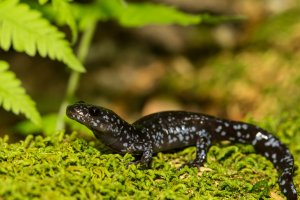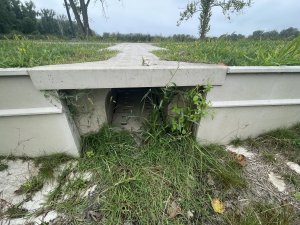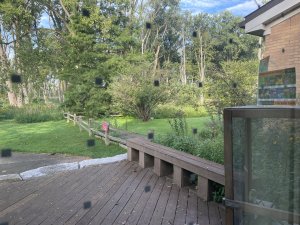Protecting Wildlife in the Parks: Window Stickers and Roadway Underpasses
September 25, 2024
By: Erin Parker, Interpretive Services Supervisor
Migration often conjures up the arrival of songbirds in the spring or perhaps the image of big flocks of geese and other waterfowl heading south at the onset of winter. We are often less aware of the daily or seasonal movements of wildlife but these migratory patterns are important, too. Animals may move daily to find food or water, seasonally to find a mate, or even shift from winter to summer habitats and back again. These movement patterns may not be as visible as songbird migration, but they can mean the difference between life and death for the animals undertaking these trips. Roads and other human structures can force animals into the pathway of cars; windows and transparent glass buildings may be invisible to birds flying at high speeds. Working with the patterns of migration and taking steps to mitigate wildlife collisions can protect a diversity of species in our parks and communities.
Safe Crossings for Wildlife
Michigan drivers hit over 50,000 white-tailed deer annually, with Oakland County in southeast Michigan being one of the top five counties in the state for deer-car accidents. The majority of these encounters happen in the autumn, when deer are moving around during the mating season and more cars are on the road at dawn and dusk due to the time change and seasonal shifts in day light length. Fencing, lighting, and trimming of shrubs and understory alongside roadways can reduce deer crossings in places such as onramps or over/under passes.

While we might be most familiar with large animal collisions, what about much smaller animals- animals we might not even see on the road?
Seasonal road closures can help during peak migration periods such as the salamander migration that takes place each spring in a park near Marquette, Michigan. As the tiny, slow-moving amphibians make their spring trek from their underground winter burrows to the vernal pools where they mate and lay their eggs. But this journey is bisected by a busy road. Counts of dead salamanders in 2019 indicated that upwards of 10-20% of Presque Isle Park’s blue-spotted salamander population were being killed by cars. Community officials worked to have the road closed through the end of March, giving the salamanders time to complete their migration.
In southern Illinois, in the Shawnee National Forest, Forest Road 345 that winds through the preserve is closed twice a year for spring and fall migrations. Uniquely situated at the base of limestone bluffs on one side and wetlands on the other, the road bisects the seasonal migration of a variety of reptiles and amphibians. The bluffs are wintering habitat for upwards of 35 species of snakes that then cross the road to their summer habitat of swampy wetlands and then back again, taking advantage of its warm surface during cool spring and fall days for basking. “Snake road”, as it is known, is open to pedestrian traffic for those wanting to observe and photograph the many species traversing the road each spring and fall.
While temporary or seasonal closures can be one solution to reducing car-wildlife problems, permanent solutions for supporting safe wildlife movement and human recreation exist, too.
Wildlife and Roads in your Metroparks
The Metroparks provide access to water and greenspace not only for the residents of and visitors to southeast Michigan, we also provide habitat for a wide diversity of Michigan wildlife throughout the seasons. And it’s important that the animals that share our parks are considered in park planning and improvements. Lake St Clair Metropark has one such structure, a tunnel underpass, installed in the entrance road to the park during road improvements in 2023. The long entrance drive, situated between marshland and the more open waters of Black Creek, is important wildlife habitat for a diverse group of organisms from snakes and turtles to muskrats and beavers. Between the warmth of the pavement, attractive to cold-

blooded animals on chilly days, the great habitat on both sides of the road, and the level of vehicle traffic, the entrance road was the site of many wildlife-vehicle collisions. To support safe wildlife movement, this underpass was added to the entrance road and lines us with a culvert on the exit road. Walls extend outwards from the underpass entrance to help funnel turtles, snakes, toads, and other wildlife into and through the structure, safely avoiding the road surface.
Before the park undertook the project, a study of the park’s wildlife, including examining the roadway for roadkill, took place in 2022, so that we could have a better understanding of which animals were being impacted and any patterns to their road crossings.
Reducing Window Collisions
According to the US Fish and Wildlife Service, almost 1 billion birds collide with glass (think windows, bus shelters, glass walkways) each year and more than 50% of those collisions are fatal. Almost all of us have had the experience of walking into glass that we didn’t see, and we have experience with glass as a solid surface that we can see, touch, and understand. Birds don’t perceive glass in these ways, and therefore don’t try to avoid it. Birds fly into it, not recognizing it as a solid, and can be injured or killed by crashing into these surfaces at high rates of speed.
One way to make windows and surfaces visible to birds is to add bird-friendly design elements that make glass less dangerous. There are several strategies that can work, one that doesn’t however is the classic hawk silhouette- birds don’t see these paper silhouettes as threatening, and they aren’t spaced out correctly on glass surfaces to make a difference. So what can we do to reduce or prevent bird strikes?

The nature centers at Oakwoods and Lake St Clair have added bird-friendly stickers, applied in a 2 x 2 or 2 x 4 inch grid, to their windows and Stony Creek Nature Center is in the process currently. These stickers are applied on the outside of windows and make the glass visible to birds without impeding the view of human visitors. Other options include Acopian bird savers, a curtain-like installation of properly-spaced strings, having specialty etched glass installed instead of clear standard glass windows, and even adjusting blinds, curtains, and window screens to reduce reflection and glare and make the windows more visible to fast-flying birds.
Migration is fraught with challenges for wildlife without adding in human impacts. Simple steps, such as adding bird-friendly elements to windows, and bigger projects like roadway underpasses added in during planned renovations, can support safety for humans and wildlife.
Resources:
Crossings: How Road Ecology is Shaping the Future of Our Planet by Ben Goldfarb
Marquette’s Presque Isle Park Closes for a Month so Salamanders Can Cross
Blue-spotted salamanders are getting their own tunnel in the UP
How roads have transformed the natural world
